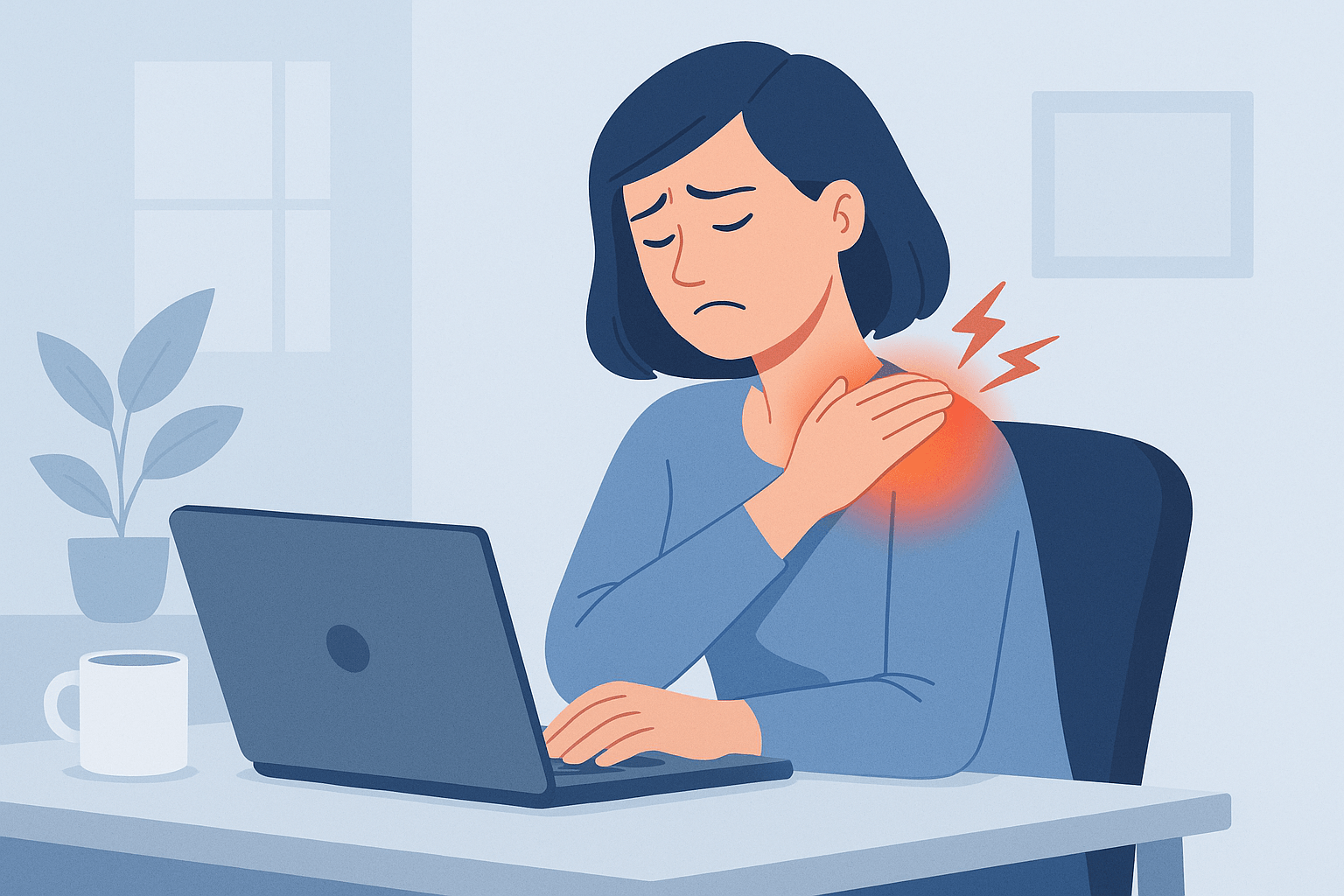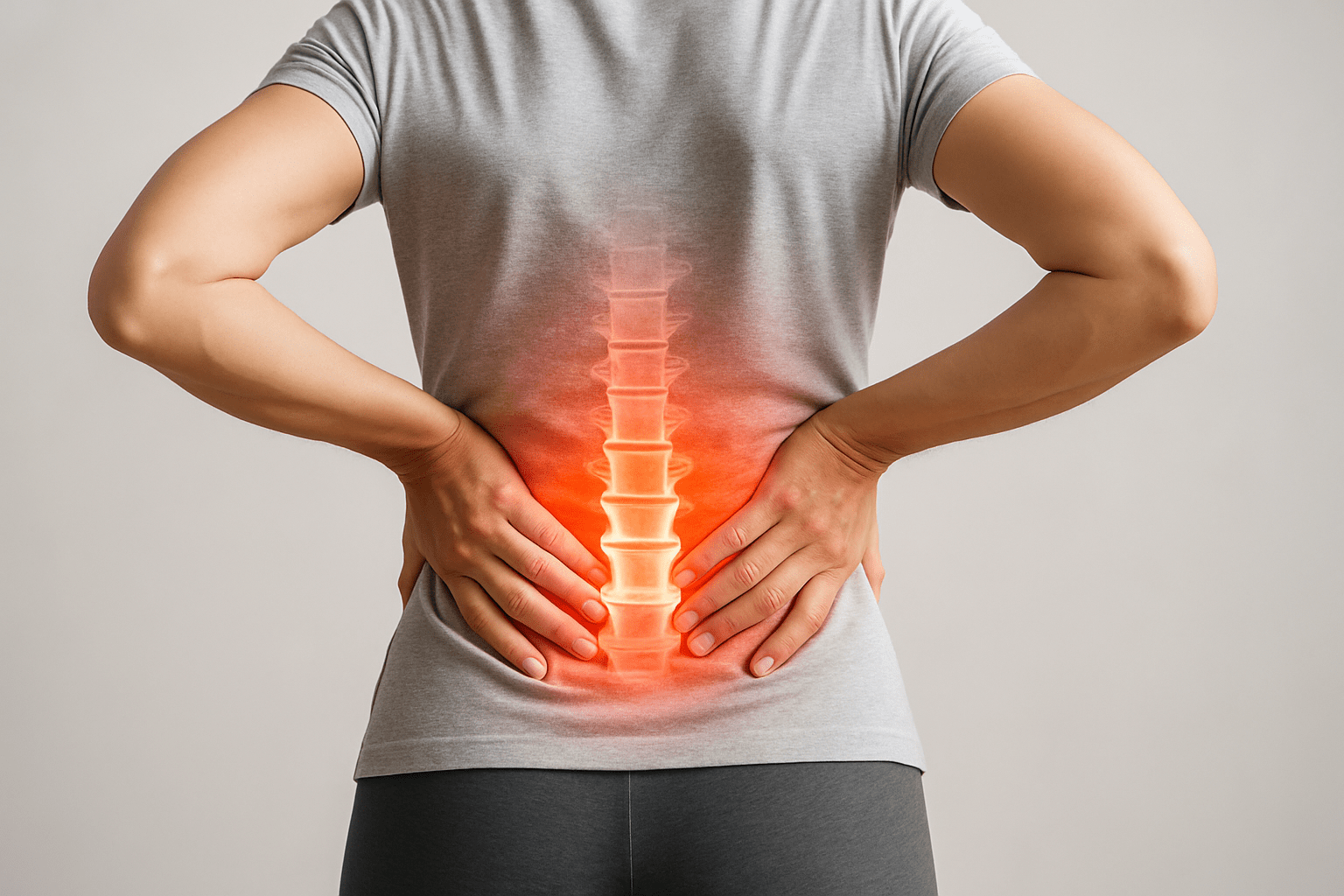Shoulder pain caused by office work: causes, symptoms, exercises & current findings (2024/2025)
Sloths hang from a branch for up to 15 hours while sleeping without getting sore muscles. And they do practically ... nothing. Unlike us: we sit in the office, look at screens and get shoulder problems. The irony? Our lack of exercise often puts more strain on the body than exercise itself. So if the next time you stretch in the meeting room you feel like you have to reassemble yourself in pieces: Welcome to the club. Shoulder pain is not a marginal phenomenon, but affects millions, especially in everyday office life. This article explains why the shoulder suffers, what you can do about it and which exercises and equipment the latest studies...


Sloths hang from a branch for up to 15 hours while sleeping without getting sore muscles. And they do practically ... nothing. Unlike us: we sit in the office, look at screens and get shoulder problems. The irony? Our lack of exercise often puts more strain on the body than exercise itself.
So if you feel like you have to reassemble yourself in pieces the next time you stretch in the meeting room: Welcome to the club. Shoulder pain is not a marginal phenomenon, but affects millions, especially in everyday office life.
This article explains why the shoulder sufferswhat you can do about it and which exercises & equipment according to the latest studies (as of 2024/2025) really help.
Reading tip: From head to toe: Everything about the holistic massage effect
Why the shoulder suffers: Common causes of shoulder pain during office work
The shoulder area is one of the most sensitive regions of the musculoskeletal system and unfortunately also one of the most stressed when we too long motionless, tense or working on one side. for too long. So while the sloth impresses with relaxed hanging muscles, ours tense up at the slightest office strain. But what exactly is the reason for this?
The causes of shoulder pain due to office work are many and varied, with several factors often working together. Here is an in-depth look at the most important triggers:
Wrong posture
A common but underestimated cause of shoulder pain is a permanently permanently unfavorable posture. Many people sit for hours on end with their head tilted forward, shoulders rounded and no contact with the backrest.
This posture puts strain on the shoulder joints, especially the subacromial gliding tissue, and leads to tension and overuse injuries to tendons, ligaments and muscles in the long term. The so-called "protracted shoulder position" - i.e. shoulders that "fall" forward - also increases the pressure in the acromion and promotes painful irritation.
Lack of exercise
Even if it sounds paradoxical: Not overloading, but understraining the muscles is one of the main causes of complaints. Sitting for hours without sufficient movement shortens certain muscle groups, particularly in the chest and neck area, while others (e.g. the upper back muscles) are overstretched and weakened.
These muscular imbalances lead to altered statics and thus to permanent incorrect loading in the shoulder/neck area. What's more: The lack of blood circulation during inactivity inhibits regeneration and promotes pain.
One-sided load
Whether mouse, telephone or coffee cup: many people use their dominant side of the body almost exclusively in the office. This monotonous strainfor example when working with a computer mouse, can lead to so-called functional scoliosis or muscular misalignment.
As a result, the shoulder on the active side is subjected to greater strain, which can lead to muscular shortening, tendon irritation or the classic "mouse arm" over weeks and months. Studies show that even small but constant movement patterns are enough to provoke unilateral pain.
Stress
Stress manifests itself not only mentally, but also physically. The connection between emotional tension and muscle tension is well documented: In stressful situations, we reflexively hunch our shoulders, breathe more shallowly and tense up unconsciously.
This chronic muscle tension, which often goes unnoticed, mainly affects the upper trapezius muscle and the neck muscles, which can result in pain in the shoulder, neck and back of the head. Particularly critical: stress-related pain often occurs even at rest and cannot be completely resolved by exercise alone. Only a holistic approach can often help here.
Unfavorable workplace
Many office workstations are not optimally adjusted to the individual body size and working method. A desk that is too low, a screen below eye level or a lack of armrests force the body into unnatural postures.
Particularly problematic: typing or clicking with "hanging arms" puts permanent strain on the shoulder joint and muscles. Studies show that an incorrect desk height or monitor position of just a few centimetres is enough to promote muscle tension in the shoulder area. The solution: An ergonomically designed workstationindividually adjustable and regularly checked.
Read more: How to promote employee health
Typical symptoms: When shoulder pain also occurs at rest
Most of us expect pain on exertion. But with shoulder pain at rest the opposite is the case: the pain does not only occur when lifting heavy loads, but often creeps in when the body should be relaxing, when the body should actually be relaxingat night in bed or when resting your arm on the couch.
This makes the complaints particularly stressful. Because they impair sleeppromote relieving postures and worsen mobility in the long term. Here are the most common symptoms in detail:
Sharp pain with everyday movements
A first warning sign for many sufferers is a sudden sudden stabbing painfor example, when putting on a sweater, lifting an object overhead or trying to grab something from the top shelf.
These complaints often indicate irritation of the so-called rotator cuff, a muscle group that is responsible for the stability and mobility of the shoulder joint. Overloading or incorrect loading causes the surrounding tissue to become inflamed, which can lead to painful friction in the joint.
Night pain - a common but often overlooked symptom
Many people report that their shoulder pain gets worse at night in particularespecially when lying on the affected side. This "night pain" often occurs with tendon irritation or the onset of calcific shoulder pain.
Lying down increases the pressure in the shoulder joint, which puts additional strain on an already irritated structure. The result: disturbed sleep, frequent turning over, problems falling asleep, a real vicious circle that has a negative effect on regeneration and pain perception in the long term [7][2][8].
Restriction of mobility
If you are suddenly no longer able to lift or rotate your arm fully, you could have a "frozen shoulder" could be the cause, a frozen shoulder that develops gradually.
This inflammatory disease leads to stiffening of the joint capsule and particularly often affects people who have not actively moved their shoulder for a long time, for example due to pain, injury or ... too much office work. Early detection is important here, as the earlier targeted exercises are started, the better the prognosis [7].
Radiating pain in the neck, arm or elbow
Not all shoulder pain is localized. In many cases they radiatefor example into the neckthe upper arm muscles or up to the elbow. This can be related to nerve irritation or involvement of the cervical spine, but also to muscle tension caused by poor posture.
A dull, pulling pain that intensifies with certain movements is typical. A precise differential diagnosis is helpful here, e.g. to recognize a so-called shoulder-arm syndrome [3][2].
Warning signs that should be taken seriously
Not all shoulder pain is harmless. There are symptoms that should definitely be clarified by a doctoras they may indicate inflammatory or even systemic processes. These include
-
Swellings
-
Overheating
-
Visible redness
-
Sensory disturbances such as numbness or tingling
-
sudden loss of strength
These warning signs can indicate bursitis, nerve entrapment or, in rare cases, even rheumatic or internal causes. Seeking medical advice at an early stage can prevent permanent damage and start targeted treatment sooner [3]. More on this later.
What the research says: Study situation and expert opinions on shoulder pain 2024/2025
The good news is that shoulder pain caused by office work is not only a widespread problem, but also one that has been scientifically well-studied phenomenon. Over the past few years, numerous research teams have looked into this, which measures actually helprelieve pain, promote mobility and prevent relapses. The latest study results from 2024 and 2025 show clear trends with practical findings for everyday life.
University of Duisburg-Essen (2024): Training significantly reduces pain at rest
In 2024, a pioneering study led by Prof. Dr. Thomas Mühlbauer at the University of Duisburg-Essen investigated the influence of targeted shoulder exercises on pain and function, with a focus on People who mainly work at a desk.
Three methods were tested in a randomized comparison group: classic strengthening exercises with the Theraband, training with a special aid (Optima® shoulder aid) and no active intervention.
The result was impressive:
After just eight weeks regular training (3x/week) participants in the active groups reported noticeable pain relief, improved mobility and a better quality of life. Particularly relevant for patients with Shoulder pain at restThe proportion of participants with nocturnal pain fell from 82% to 35% - a reduction that was not observed without active exercise.
Training with equipment tended to show even better results than Theraband exercises alone [9].
Liebscher & Bracht (2025): Fascia and stretching programs work quickly
Alternative training methods are also increasingly finding their way into practice - especially if they can be easily integrated into everyday life. In 2025, exercise therapists Liebscher & Bracht published new results from their user studies, which demonstrate the benefits of regular stretching and mobilization exercises confirmed.
Targeted stimulation of the muscles, fascia and joint structures not only improves mobility, but also optimizes the joint position, resulting in noticeably reduced pain leads to noticeably reduced pain.
Particularly noteworthy: Many users report quick successesoften after just a few weeks. The method emphasizes active self-helpan approach that is particularly practical for working people with sedentary jobs [2].
German Register of Clinical Studies (2024/25): Osteopressure in focus
In parallel, a new, currently ongoing study in the German Register of Clinical Studies (DRKS) the therapeutic effect of osteopressure, combined with targeted exercises. The focus here is on the so-called subacromial pain syndromea common form of shoulder pain that can be triggered by office work, lack of exercise or overhead work.
The aim of the study is to record the effect of manual impulse techniques on pain processing, joint function and mobility. Initial interim reports indicate that active interventions, whether manual or through exerciseare significantly more effective than pure rest or pain medication [3].
Whether classic strength training, targeted stretching or modern manual therapy: all effective effective approaches rely on active participation. Current research makes this clear:
Regular exercise and targeted mobilization not only reduce acute pain, but also prevent chronic pain.
These exercises really help (according to 2024/2025 studies)
As you can see from the studies above, even training three times a week can significantly reduce pain, especially with targeted strengthening and mobilization. And here are a few short exercises for more relief, especially with targeted strengthening and mobilization.
|
Exercise |
Effect & description |
Source |
|
Shoulder and neck stretching |
Slowly roll your head forwards and to the side, hold for 40 seconds |
[5] |
|
"Billiard ball" exercise |
Consciously lower your shoulders, relieve strain on your neck |
[5] |
|
"Liberated upper back" |
Press your arms together in front of your body, maintain tension |
[5] |
|
Chest opener |
Wall stretching for chest muscles |
[5] |
|
Strengthening with Theraband |
Strengthen external rotators, reduce pain and night pain by 50 % [9] |
[9] |

Our tip: Supplement your training with a massage device for shoulder paine.g. the MSW Shiatsu massager for neck and shoulders. Perfect for relaxing in the evening or during your lunch break.
You can find more inspiration here: Electric massagers for different needs
Preventing shoulder pain - how to stay pain-free in the office in the long term
As we have already learned, anyone who sits at a desk every day knows that the body forgets nothing. Small incorrect postures, rigid positions or missed breaks add up and sooner or later become a problem. But the good news is: With the right prevention, you can effectively avoid shoulder pain. This doesn't require radical changes, but smart adjustments to your everyday life.
Here are the most important strategies to keep your shoulder healthy in the long term:
1. ergonomics first: adapt the workstation
The basis for working without complaints is an ergonomically designed workplace. Just a few adjustments can significantly reduce the strain on your shoulder muscles. Make sure that your screen is at eye level and about one arm's length away away. A height-adjustable office chair with armrests relieves strain on the shoulders during long periods of sitting.
Also keyboard and mouse should be in close proximity to the body, ideally supplemented by wrist rests. wrist reststhat stabilize the posture of the forearms. If you can, integrate a sit-stand desk or work standing up in phases, which promotes blood circulation and activates stabilizing muscles [6].
2. micro-movements and breaks: stay active, even when seated
Even the most ergonomic workstation is only of limited help if you stay in the same position for hours on end. That's why one golden rule is Exercise in small doses, regularly rather than radically.
Plan a short break every 45-60 minutes: Stand up, shake out your arms, roll your shoulderswalk a few steps around the office. Just a few seconds of these so-called micromovements can prevent tension and improve blood circulation [10].
Tip: Set a gentle alarm clock or use reminder apps to remind you to take exercise breaks - ideal for concentrated working days.
3. integrate exercise into everyday life
Exercise doesn't have to start in the gym, it can be part of everyday life. Instead of taking the elevator, take the stairs. Instead of talking on the phone at your desk, take a few steps. Instead of just scrolling during your lunch break, take a 5-10 minute walk around the block.
Also Mobilization exercises directly at the desksuch as shoulder circles, stretching the chest or arm rotations, have been shown to have a preventive effect against muscular imbalances [5].
4. compensatory sport: the shoulder needs training
Anyone who sits for long periods should provide targeted compensation through sports that improve posture, mobility and strength. Particularly suitable:
-
Swimmingthat moves the shoulders symmetrically
-
Yogathat combines stretching and mindfulness
-
Pilateswhich strengthens the deep muscles in the shoulder girdle [1]
These activities not only help to relieve existing tension, they also preventively strengthen the postural muscles that protect you in everyday working life.
5. use massage devices: Actively promote regeneration
Sometimes external support is needed, especially after a long day of meetings, emails and mouse movements. Targeted stimulation through massage can help, release trigger points, relax the muscles and promote blood circulation.
The MSW massager shoulder/neck massager with heat function is ideal for use after work or during a short break between two video calls. The combination of Shiatsu technology and heat treatment can make a noticeable contribution to pain relief and support regeneration.
Discover more MSW massagers for neck, shoulder & back: To the overview
The best therapy for shoulder pain is still prevention before it hurts. With ergonomic adjustments, conscious breaks, targeted exercise and small everyday changes, you can create an environment in which your shoulder can stay healthy without any major effort.
When you should see a doctor for shoulder pain
As helpful as self-help, exercises and ergonomic adjustments are, there are situations in which you should no longer hesitate, but rather seek professional advice. After all, not all shoulder pain is harmless; sometimes there are inflammatory, neurological or even internal causes behind it that need to be treated early on.
To help you recognize warning signs in good time, here are the most important reasons to see a doctor if you have shoulder pain:
1. severe or chronic pain (longer than 3 months)
If you suffer from persistent shoulder pain despite stretching exercises, massages or posture corrections, you should not wait any longer for improvement. Especially if the pain is severe, sharp or persistent, e.g. at night or with the smallest movements, there may be a structural cause, such as tendonitis, calcific shoulder or a bottleneck syndrome in the shoulder joint. A medical examination (possibly with ultrasound or MRI) provides clarity and enables targeted treatment.
2. numbness, tingling or restricted movement
If neurological symptoms occur in addition to the pain - such as tingling in the arm, loss of feeling in the fingers or a noticeable loss of strength - this indicates a possible irritation or constriction of nerves. Possible triggers are, for example, a pinched nerve in the cervical spine or a bottleneck in the shoulder (thoracic outlet syndrome). In these cases, a neurological or orthopaedic examination is urgently recommended.
3. swelling, redness, overheating or fever
Even if the pain is new and is accompanied by visible signs of inflammation, e.g. a swollen, reddened or clearly warm shoulder, you should consult a doctor as soon as possible. Possible causes include acute bursitis, a bacterial infection or a rheumatic disease. In combination with a fever, it is even a potential medical emergency.
4. sudden left-sided shoulder pain with shortness of breath or chest pain - emergency!
Particularly important and unfortunately often underestimated: a sudden onset of severe shoulder pain on the left side, which is also accompanied by shortness of breath, chest pain, nausea or a feeling of tightness in the chest, may indicate a heart problem. Lung or vascular diseases (e.g. embolisms) also sometimes manifest themselves as seemingly "banal" shoulder pain.
In such cases, call the emergency services immediately (112), because every minute counts.
Not every pain has to take you to the doctor's surgery straight away - but if symptoms do not improve, change or are accompanied by unusual symptoms, you should take action. An early diagnosis not only provides clarity, but also increases the chance of a quick and complete recovery.
Shoulder pain from office work? Take action now - before your body gets stuck
Unlike the sloth, which dangles from its branch with impressive composure, our shoulder is not made for hours of passivity. On the contrary: Shoulder pain caused by office work is no longer an exception, but an everyday occurrence for many working people, caused by monotonous posture, lack of exercise and stress.
But you don't have to put up with it.
Current studies clearly show that Targeted exercisesan ergonomic workplace design and regular exercise breaks can alleviate the symptoms sustainably alleviate and often even prevent them altogether. Whether classic strengthening, mobilization with aids or small adjustments in everyday life - every measure counts.
Because exercise is not a burden - it is your best relief.
Other articles that might interest you:
Disclaimer: This article does not replace medical advice. You should always seek medical advice if you have severe symptoms or are unsure.
List of sources
[1] Federal Center for Health Education (BZgA): Exercise in everyday life - why it is so important.
[2] Liebscher & Bracht (2025): User report on stretching exercises for shoulder complaints.
[3] German Register of Clinical Studies (DRKS): Ongoing study on osteopressure and exercise for shoulder pain.
[4] German Pain Society e. V.: Information on myofascial pain.
[5] MSW Editorial Team: 5 effective shoulder exercises for the office - Blog article, 2024.
[6] BAuA (Federal Institute for Occupational Safety and Health): Ergonomic recommendations for VDU work.
[7] Orthopaedic University Hospital Heidelberg: Clinical Guideline "Frozen Shoulder", 2023.
[8] German Society for Orthopaedics and Trauma Surgery (DGOU): Calcified Shoulder - Recognition & Treatment.
[9] University of Duisburg-Essen (2024): Study on the effectiveness of Theraband training and the Optima® shoulder aid.
[10] Harvard Health Publishing: Micromovements and workplace health, 2022.

Co-founder and Managing Director of Massage Chair World. With his expert knowledge and industry expertise, he helps private individuals and companies to find the right massage chairs for relaxation, health and vitality. The individual expert advice is provided both by telephone or video chat, as well as in the exhibition outside Stuttgart.




